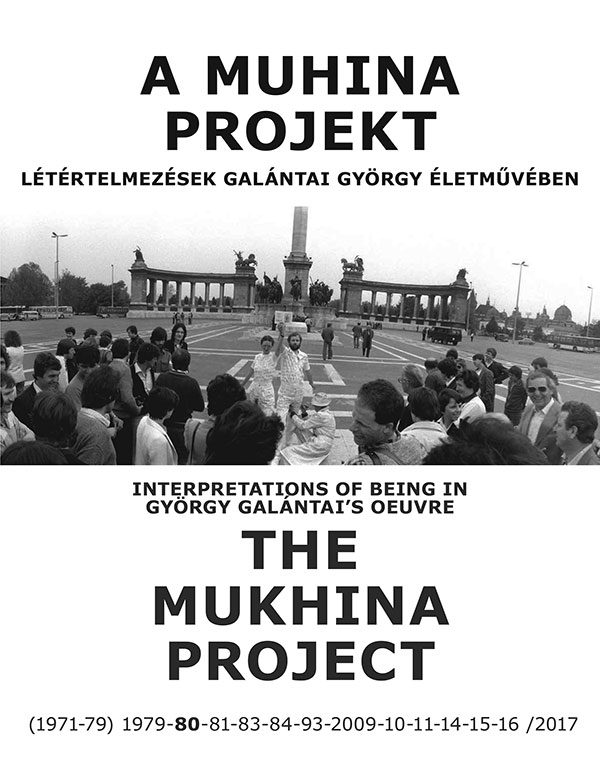THE MUKHINA PROJECT
INTERPRETATIONS OF BEING IN GYÖRGY GALÁNTAI’S OEUVRE
An English and Hungarian bilingual volume has recently been published by the Vintage Gallery under the title The Mukhina Project. Interpretations of Being in György Galántai’s Oeuvre* with the event of 24 May 1980 on Heroes’ Square at its focus.

During the three-hour action realised based on György Galántai’s concept György Galántai and Júlia Klaniczay were standing in the pose of Vera Mukhina’s iconic sculpture titled Worker and Kolkhoz Woman but holding the book in which the work was reproduced instead of the scythe and hammer featured in the original statue; in the meantime, Guglielmo Achille Cavellini was writing the list of the greats of art history on their clothes. Upon György Galántai’s request, photographer György Hegedüs documented the event with photos (including the then extremely rare panoramic shots). The selection of these photographs, supplemented with relevant documents, was exhibited by the Vintage Gallery in autumn 2017.
The volume with extensive photographic material embeds the action (event) of 1980 into a theoretical, historical and cultural history context with the photographs being supplemented with diary entries, reproductions of Galántai’s related works, excerpts from Cavellini’s texts and some of his works that bear relevance to the Mukhina action. An in-depth interview (edited by Júlia Klaniczay and György Galántai) in which Galántai answers questions asked by Flóra Barkóczi, Kristóf Nagy, Gabriella Schuller and Panni Szirmai, takes readers along a journey through the book. The interview makes it possible to reconstruct the exact circumstances of the creation and the implementation of the Hommage à Vera Mukhina project while also helping to understand the wider context: in each one of his periods Galántai responded to the world around him and the questions he was preoccupied with by creating concrete works, in which he formulated his interpretations of Being (hence the plural in the title of the volume). At the same time, the periods and interpretations of Being laid over one another also facilitate the definition of some essential statements about Galántai’s entire oeuvre.
The last third of the volume discusses the afterlife of the Hommage à Vera Mukhina project, exploring it with the same thoroughness that is characteristic of the rest of the book. Although Galántai’s initial plan was to realise the performance on Heroes’ Square as a one-off event, he made five adaptations to it during the 1980s. First came the photo-actions in Székesfehérvár and Szombathely (both in 1981), addressing the issue of art institutions and their canons in the form of Galántai and Klaniczay as ‘living statues’ confronting the exhibitions that showcased the past and the present. These were followed by a walk on Felvonulás (Procession) Square in Budapest in 1983 and a performance at the symposium Border Signs, held in Breitenbrunn, Austria in 1984, which both took on a more direct approach: the walk, which included a visit to the Lenin statue on the square, was an ironic and playful deconstruction of the self-representation of the regime, while the performance in Breitenbrunn played with the location and the year to create a rather powerful symbol of being locked up behind the iron curtain both physically and mentally. Finally, the actions and video work (1980-81) realised at the textile art workshop in Velem opened the interpretational framework of the Mukhina project into the direction of participatory art and film.
The structure of the book shows intellectual kinship with the artists’ books inspired by Fluxus and concept art that were published in the late 1960s and early 1970s. In conventional western culture image and text are mutually referential with the image directly illustrating the text while the text was progressing towards unfolding a final meaning, while in artists’ books (often linked to the documentation of an art event) this connection is looser. In the Mukhina Project volume the relation between the images and the text is reversed: the text interprets the images; moreover some parts of the text are handled as images with their arrangement in the book not necessarily following a linear-chronological order. Browsing through the publication, the reader can see the art of documentation at work – the interpretation of documents as an autonomous art medium.
After the changes of 1989 the Hommage à Vera Mukhina soon grew into an iconic piece and as such a permanent fixture in international exhibitions organised on the art of the period; this diverse afterlife of the project is naturally explored by the volume. The project most likely owes its popularity to the fact it encapsulates several key motifs that are crucial to understanding this period: it challenges the concept of social and gender roles, addresses the issue of politics being the sole proprietor of all the art media and proposes the deconstruction of power symbols. Hence, the interpretation(s) of Being in the Hommage à Vera Mukhina project are not only applicable to Being on an individual level but to Being in a more widely understood historical period and region.
The volume ends with György Galántai’s Fluxus biography, drawing into his personal sphere all of the issues pertaining to cultural history and the philosophy of art that are discussed in the book.
